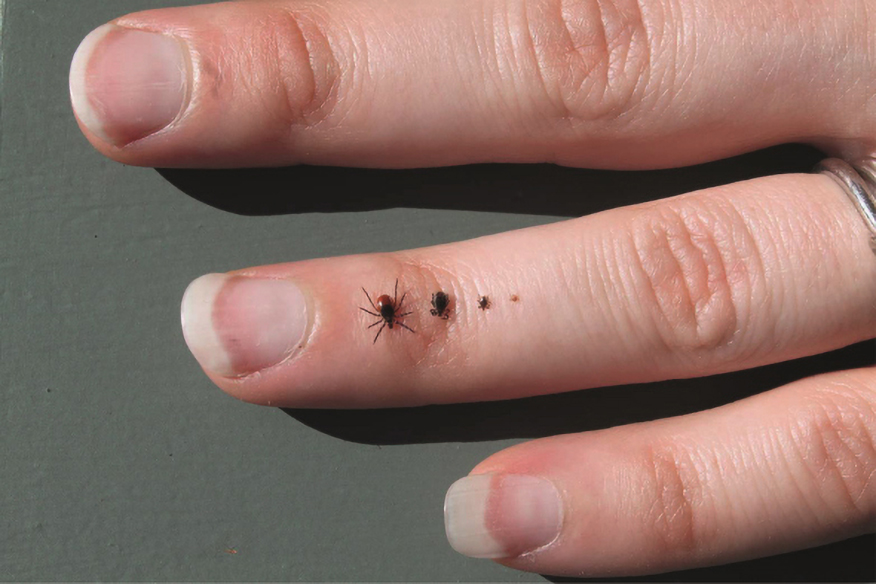
:max_bytes(150000):strip_icc()/what-to-know-about-tick-bites-4587783_V2-3d1cf872c1fd41a79b01372a08c75d9c.png)
arthritis (usually seen as pain and swelling in large joints, especially the knee).irregular heartbeat and/or heart palpitations.Later-stage symptoms may not appear until weeks or months after a tick bite. As many as 80% of infected people may develop a rash, however the characteristic “bull's-eye” rash appears only 20% of the time. Symptoms of early-stage Lyme disease include:Īnother common symptom of Lyme disease is a rash (referred to as “Erythema migrans”). to aid in the prevention of Lyme disease in people. There are no licensed vaccines available in the U.S.

Do a careful body check for ticks after outdoor activities.Remove your clothing after being outdoors, and wash and dry them at high temperatures.Walk in the center of trails to avoid brush and grass.Tuck pant legs into socks or shoes, and tuck shirts into pants.Wear long pants and long-sleeved shirts, and shoes that cover the entire foot.Apply insect repellents on uncovered skin, and ensure the products are registered by the Environmental Protection Agency.Treat clothing and gear with products containing 0.5% permethrin.Wear light-colored clothing so that you can see ticks that get on you.Avoid wooded, brushy, and grassy areas, especially during warmer months (April – September), although tick exposure can occur anytime.For more information on the safe removal, disposal and identification of ticks visit CDC.gov/ticks. To avoid infecting yourself, never crush a tick with your fingers. Not all ticks carry Lyme disease, and some ticks carry other diseases. Thoroughly clean the bite area and your hands with rubbing alcohol, an iodine scrub, or soap and water.Your goal is to remove the entire tick, ideally in one piece, including the mouth parts embedded under the skin. Pull upward with steady, even pressure.Using fine-tipped tweezers, grasp the tick as close to the skin’s surface as possible.Similarly, a mild winter can allow ticks and other insects to thrive and emerge earlier than usual. But this can extend into the warmer months of early autumn, or even late winter if temperatures are unusually high. In the majority of cases, tick bites are reported in the summer months when ticks are most active and people spend more time outdoors. Symptoms of Lyme disease may take 3-30 days or longer to appear. If you remove it within 24 hours, the risk is greatly reduced. In most cases, a tick must be attached for 36 to 48 hours or more before the Lyme disease bacterium can be transmitted. Read more about the lifecycle of the bacteria and how it is transmitted to people and dogs. Deer are important sources of blood for ticks and are important to tick survival and movement to new areas, increasing the contact between people and ticks that carry the bacteria. As many a suburban gardener can attest, with the expansion of the suburbs and a push to conserve wooded areas, deer populations are thriving. And while everyone is susceptible to tick bites, campers, hikers, and people who work in gardens and other woody, and brushy areas with high grass and leaf litter, are at the greatest risk of tick bites. On people, you will most often find ticks in moist or hairy areas such as the groin, armpits, scalp, and other hard-to-see areas of the body. Pay particular attention to the collar area and around the eyelids, ears, tail, under the front legs, and between the back legs and toes. The CDC recommends you check your dog daily, especially after they spend time outdoors. Lyme disease is a bacterial infection most commonly transmitted via the bite of infected ticks, which attach to any part of the body. Who Gets Lyme Disease, What Time of Year? Food and Drug Administration regulates products that are used to help prevent, diagnose, and treat this complex disease. However, not all diagnosed cases are reported and the CDC believes the true number of human infections is likely closer to 476,000 per year. increased from about 12,000 annually in 1995 to approximately 35,000 in 2019, according to the Centers for Disease Control and Prevention. Tick-borne diseases, such as Lyme disease, are on the rise in people and dogs.


 0 kommentar(er)
0 kommentar(er)
